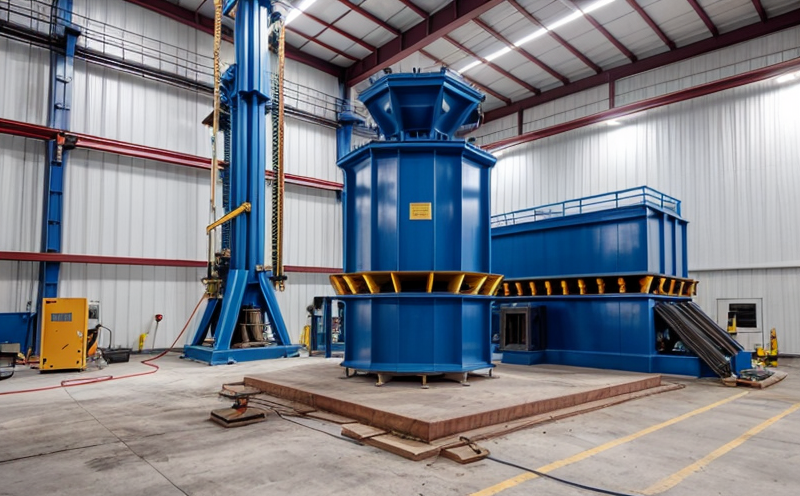ISO 7626-8 Experimental Determination of Modal Parameters
The ISO 7626 series provides a comprehensive framework for modal testing, focusing on various aspects of mechanical vibration. The specific standard we are discussing here is ISO 7626-8, which deals with the experimental determination of modal parameters using random excitation and cross-correlation techniques.
Modal analysis plays a crucial role in structural health monitoring, ensuring that structures meet design specifications and perform reliably under operational conditions. By accurately determining the natural frequencies, damping ratios, mode shapes, and other modal parameters through this standardized method, engineers can identify potential issues early on, enhancing both safety and efficiency.
The process involves subjecting a structure to random excitation within its operating frequency range while measuring displacement responses at multiple points. This data is then analyzed using cross-correlation functions to extract the desired modal information. It's important to note that this technique requires precise environmental control during testing, including temperature stability and minimal external disturbances.
Proper specimen preparation is critical for obtaining accurate results. Specimens should be representative of actual components or assemblies being evaluated, with any necessary modifications made prior to testing according to relevant standards such as ISO 18431-2 for structural health monitoring systems. Appropriate instrumentation must also be selected based on expected frequency ranges and sensitivity requirements.
Once collected, the data undergoes rigorous processing using specialized software tools that perform complex calculations necessary for extracting meaningful insights about the specimen's dynamic behavior. Compliance with ISO standards ensures consistency across different laboratories conducting similar tests, facilitating easier comparison of results among peers within the industry.
This service not only helps ensure compliance but also supports continuous improvement efforts by providing valuable feedback on design iterations and manufacturing processes. For quality managers responsible for maintaining high standards throughout production cycles, this level of detail ensures that every aspect contributing to product performance is accounted for.
For R&D engineers seeking innovative solutions or improvements in existing designs, having access to precise modal data allows them to make informed decisions regarding material selection, geometrical modifications, and other factors influencing overall structural integrity. Additionally, procurement professionals benefit from knowing what criteria must be met during vendor evaluations, helping ensure that suppliers deliver products capable of withstanding anticipated loads without compromising on safety margins.
In summary, ISO 7626-8 provides a robust approach to experimental determination of modal parameters which is essential for ensuring structural integrity and performance. Its application across various sectors ranging from automotive manufacturing to aerospace design underscores its importance in today’s engineering landscape.
Why It Matters
The importance of accurate modal analysis cannot be overstated, especially when dealing with complex structures subjected to dynamic loading conditions. Properly conducted tests not only enhance product reliability but also contribute significantly towards reducing lifecycle costs associated with failures or recalls.
By identifying weak points early in the design cycle, manufacturers can implement corrective measures before mass production begins, thereby minimizing waste and rework. Furthermore, ongoing monitoring allows for proactive maintenance strategies that extend asset lifespans while maintaining optimal operational efficiencies.
The ability to predict failure modes accurately helps prioritize resource allocation towards high-risk areas, ensuring efficient use of both human capital and financial resources. This ultimately leads to enhanced competitiveness within competitive markets where reliability is a key differentiator between products.
Scope and Methodology
The scope of ISO 7626-8 encompasses the process of determining modal parameters through random excitation and cross-correlation techniques. It applies to various types of structures, including but not limited to mechanical assemblies, civil engineering components, and aerospace elements.
Random excitation ensures that all modes within a structure are excited equally during testing, providing comprehensive coverage rather than focusing on just one or two dominant frequencies. Cross-correlation functions allow for precise extraction of modal parameters by analyzing the relationship between different displacement measurements taken at various points across the specimen.
The methodology outlined in ISO 7626-8 emphasizes the need for controlled environments during testing to minimize external influences such as ambient noise and temperature fluctuations. This ensures that only intrinsic characteristics of the specimen are captured, leading to more reliable results.
Specimen preparation plays a vital role in obtaining accurate modal data. Careful selection of test points and careful alignment relative to the excitation source help ensure consistent measurements throughout the testing process. Proper instrument calibration is also crucial for ensuring that all readings align with expected values.
Competitive Advantage and Market Impact
Adopting ISO 7626-8 modal analysis practices offers several competitive advantages, particularly in highly regulated industries where compliance is non-negotiable. Meeting these standards demonstrates a commitment to quality and safety, setting brands apart from competitors who may not adhere strictly to such rigorous protocols.
In terms of market impact, adhering to international standards like ISO 7626-8 enhances brand reputation among consumers and stakeholders alike. It establishes credibility both domestically and internationally, fostering trust in the products offered by companies practicing these stringent methods.
From a business perspective, compliance with such standards helps reduce risks associated with non-compliance penalties or recalls. By ensuring that every step of the manufacturing process adheres to established guidelines, companies can avoid costly disruptions caused by regulatory issues down the line.
Moreover, leveraging advanced modal analysis techniques enables companies to innovate more effectively, pushing boundaries in terms of performance optimization and cost reduction without compromising on quality standards.





